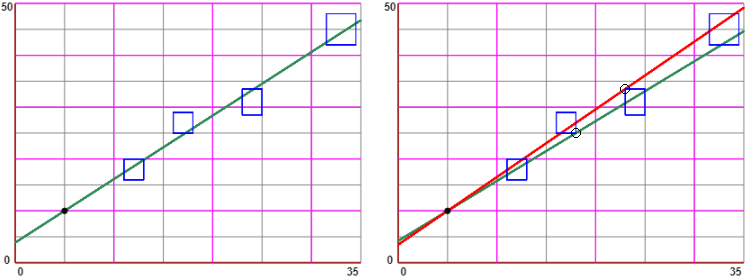
Con Lx,Ly, ..., L7x,L7y posso anche tracciare "punti" con ascisse e ordinate rappresentate da intervalli di indeterminazione. Un esempio:
With Lx, Ly, ..., L7x, L7y I can also plot "points" with abscissas and ordinates that lie within specified ranges
instead of having definite values (interval arithmetic). An example:

Che cosa posso dire della funzione lineare F tale che F(5)=10 il cui grafico passa per i punti seguenti?
What can I say about the linear function F such that F(5)=10 whose graph passes through the following points?
x: 12±1 17 ±1 24±1 33±1.5
y: 18±2 27±2 31±2.5 45±3
Il grafico a sinistra ha, semplicemente, tracciato la retta di regressione passante per il punto (5,10), trovata con:
The graph on the left has simply plotted the regression line passing through the point (5,10), found with:

function g(x) { y = 1.225*x+3.875; return y }
aX = 0; bX =35; aY = 0; bY = 50
Dx = 5; Dy = 5
xx=[10,20,30]; yy=[10,20,30,40,50]
Px=[5]; Py=[10]
D1=12; E1=1; D2=18; E2=2; Lx=[D1-E1,D1+E1,D1+E1,D1-E1,D1-E1]; Ly=[D2-E2,D2-E2,D2+E2,D2+E2,D2-E2]
D1=17; E1=1; D2=27; E2=2; L1x=[D1-E1,D1+E1,D1+E1,D1-E1,D1-E1]; L1y=[D2-E2,D2-E2,D2+E2,D2+E2,D2-E2]
D1=24; E1=1; D2=31; E2=2.5; L2x=[D1-E1,D1+E1,D1+E1,D1-E1,D1-E1]; L2y=[D2-E2,D2-E2,D2+E2,D2+E2,D2-E2]
D1=33; E1=1.5; D2=45; E2=3; L3x=[D1-E1,D1+E1,D1+E1,D1-E1,D1-E1]; L3y=[D2-E2,D2-E2,D2+E2,D2+E2,D2-E2]
AX = ""; BX = ""; AY = ""; BY = ""
AAX="0"; BBX="35"; AAY="0 "; BBY="50"
linew=1
Ma non abbiamo alcuna informazione sulla precisione di questa "g" / But we have no information on the accuracy of this "g"
Il grafico a destra traccia la retta di minima pendenza che passa per tutti i rettangoli e la retta di massima pendenza
che passa per tutti i rettangoli. Le pendenze sono
The graph on the right plots the line of minimum slope that passes through all the rectangles and the line of maximum slope that passes through all the rectangles. The slopes are
function g(x) { y = 15/13*(x-5)+10; return y }
function h(x) { y = 23.5/18*(x-5)+10; return y }
(15/13 + 23.5/18) / 2 = 1.2297… (23.5/18-15/13) / 2 = 0.07585#133;
La migliore conclusione è che la funzione è la seguente /
The best conclusion is that the function is as follows:
F: x → (1.230±0.076)*(x-5)+10